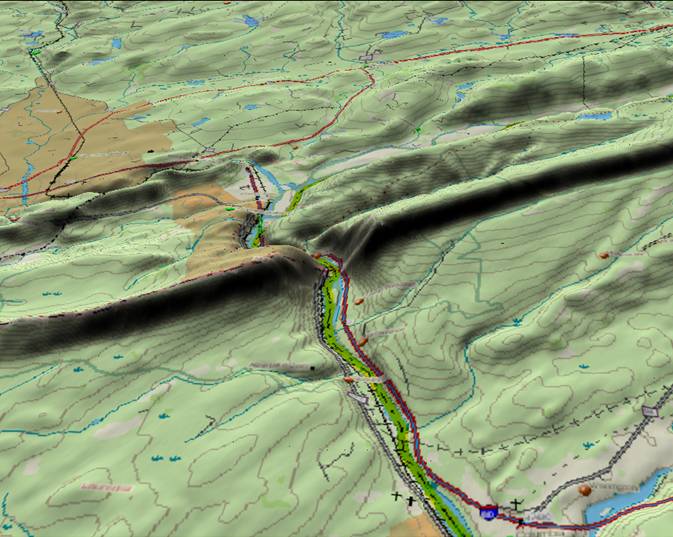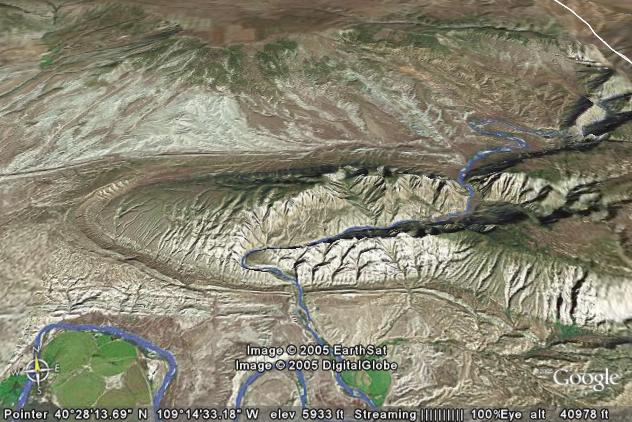
Durango Bill’s
Ancestral Rivers of the World
Ancestral River
Systems of the World
by
Bill Butler
by
Bill Butler
Introduction and
Links to the Pages
These web pages contain a brief listing (with pictures) of multiple world locations where river systems cut through mountain ranges instead of taking easier routes around them. The processes that produce river systems that cut through mountain ranges require millions of years of geologic history. As such, they are evidence that the Earth we live on as been around for many millions (actually billions) of years.

The picture above shows the Delaware Water Gap. There is more information about it in the “Ancestral Rivers of the Eastern United States” section. All pictures on this page (and the linked pages) were generated by either Delorme’s Topo USA computer program or by Google Earth.
There are multiple areas throughout the world where river systems cut through mountain ranges instead of taking easier routes around them. These apparently “illogical” river paths are actually records of earlier ages when these rivers established their paths along expected downhill routes. Subsequent geologic forces changed the shape of the landscape, but these rivers had enough erosion power to maintain their original paths.
Antecedence
There are two geological principles governing the processes involved. The most common is “antecedence”. In antecedence, the river involved was in place first. Subsequently the mountain range rose, but the river played the part of a stationary band saw. The river stayed put, but it cut a groove into the rising mountain range. The more familiar name for a “groove” is a “canyon”.
When a land area is uplifted above sea level, river drainage systems will develop to carry excess rainfall back to the ocean. These rivers will occupy the lowest areas available. Subsequent tectonic forces may start building a mountain range across the path of the river. If the river can not erode down fast enough, the rising mountain range will act as a dam, and the river will seek out the next easiest alternative for a new course. On the other hand, if the river can erode down as fast as the new mountain range rises, it will dig a canyon through the rising mountain range.
We look at this process and frequently (falsely) imagine that in the past the river was at the same elevation as the current high elevations of the mountain range. We then wonder how and why the surrounding lower terrain could have supported a river at this elevation. In fact an easier process is at work. Quite frequently the lower surrounding terrain is a reasonable approximation of the ancestral elevation of the river. After the river established its ancestral course, the mountain range rose. The river played the part of a stationary band saw. It cut a groove into the rising block of land.
Superimposition
The other process that can cause rivers to cut through mountain ranges is superimposition. Here, the mountain range was in place first. Over many millions of years erosion will erode a mountain range down to mere stubs. Also, nearby rivers may drop some of their sediment to fill in adjacent lowlands. Eventually, you end up with a flat surface. If mountain building (or just subtle changes in the tilt of the land surface) causes rivers to relocate to new positions on this flat surface, it is quite possible one of these new river channels may end up directly over the ancient beveled mountain range.
Subsequently, if there is a general uplift of all the surrounding terrain or if a lower exit elevation for the area should develop, erosion will set in. The newer, softer sediments that helped bury the stubs of the old mountain range will be easily eroded away. The remnants of the old mountains will have harder rock and will tend to resist erosion. Thus the old stubs will reemerge as surrounding areas erode away. However, the river may remain “stuck in its rut” and simply erode down into the old mountain range.

Split Mountain, Utah is an example of superimposition. You can read about its history at “Canyon of Lodore, Colorado and Split Mountain, Utah”. http://www.durangobill.com/Lodore.html
Ancestral Rivers
of the World
The following pages link to specific areas of the world where examples of these processes can be seen. Some are low elevations that tend to be overlooked. Others are in areas where you would think it would be impossible for a river system to cut through a high mountain range. This includes the highest range of all - the Himalayas. Who would think that a current river could cut north to south across the Himalayas just 28 miles east of Mt. Everest. Thanks to Google Earth, there is a picture of exactly this phenomenon on the “Asia” page.
Ancestral Rivers in the Eastern United States
Hudson River - Taconic Mountains,
New York
Delaware Water Gap, New Jersey / Pennsylvania
Susquehanna River, Pennsylvania
Potomac River at Harper Ferry, Maryland / Virginia
New River, Virginia
French Broad River - Asheville, NC to Knoxville, TN
Tennessee River, Alabama
Delaware Water Gap, New Jersey / Pennsylvania
Susquehanna River, Pennsylvania
Potomac River at Harper Ferry, Maryland / Virginia
New River, Virginia
French Broad River - Asheville, NC to Knoxville, TN
Tennessee River, Alabama
Ancestral Rivers in the Colorado River Basin
Please see Evolution of the
Colorado River http://www.durangobill.com/Paleorivers_preface.html
and
Image Index http://www.durangobill.com/ImageIndex.html
and
Image Index http://www.durangobill.com/ImageIndex.html
Ancestral Rivers in other areas of the Western United States
Rio Grande River - Santa Elena
Canyon, Texas
Wind River (Big Horn River), Wyoming
Shoshone River, Wyoming
Weber River and Ogden River, Utah
Snake River, Idaho / Montana
Columbia River, Oregon / Washington
Wind River (Big Horn River), Wyoming
Shoshone River, Wyoming
Weber River and Ogden River, Utah
Snake River, Idaho / Montana
Columbia River, Oregon / Washington
Ancestral Rivers in Mexico, Western Canada, and Alaska
Bustamante Canyon, Mexico
Peace River, British Columbia
Stikine River, British Columbia / Alaska
Alsek River, Yukon Territory / Alaska
Copper River, Alaska
Nenana River, Alaska
Delta River, Alaska
Peace River, British Columbia
Stikine River, British Columbia / Alaska
Alsek River, Yukon Territory / Alaska
Copper River, Alaska
Nenana River, Alaska
Delta River, Alaska
Ancestral Rivers in South America
Baker River, Lago Buenos Aires
(General Carrera), Argentina & Chile
Cisnes River, Chile
Grande River, Bolivia
Rio Pascua (Pascua River), Lago San Martin (Lake O’Higgins), Argentina & Chile
Patia River, Columbia
Pilcomayo River, Bolivia
Cisnes River, Chile
Grande River, Bolivia
Rio Pascua (Pascua River), Lago San Martin (Lake O’Higgins), Argentina & Chile
Patia River, Columbia
Pilcomayo River, Bolivia
Ancestral Rivers in Europe
Danube River, Serbia /
Romania
Fier River, France
Labe River (Elbe River), Czech Republic
Olt River, Romainia
Rhine River, Germany
Salzach River (Salzburg River), Austria
Unknown tributary to the Pechora River, Ural Mountains, Russia
Fier River, France
Labe River (Elbe River), Czech Republic
Olt River, Romainia
Rhine River, Germany
Salzach River (Salzburg River), Austria
Unknown tributary to the Pechora River, Ural Mountains, Russia
Ancestral Rivers in Asia
Arun River, Himalayan Mountains,
China (Tibet), Nepal, India
Euphrates River, Syria
Indus River, Pakistan
Jhelum River, India controlled Kashmir
Selenge River, Russia
Sutlej River & Bhakra Dam, India
Tigris River, Iraq
Yangtze River, China (2 pictures)
Yenisey River, Russia
Euphrates River, Syria
Indus River, Pakistan
Jhelum River, India controlled Kashmir
Selenge River, Russia
Sutlej River & Bhakra Dam, India
Tigris River, Iraq
Yangtze River, China (2 pictures)
Yenisey River, Russia
Ancestral Rivers in Africa
Arroyos (“intermittent rivers”),
Algeria
Blue Nile (Abay River), Ethiopia
Congo River, Democratic Republic of the Congo and the Republic of the Congo
Lufira River, Upemba Natl. Park, Democratic Republic of the Congo
Lukuga River, Lake Tanganyika, Democratic Republic of the Congo
Luvua River, Lake Mweru, Democratic Republic of the Congo & Zambia
Meiringspoort Gorge, Groot River, South Africa
Nile River, Sixth Cataract, Sabaloka Gorge, Sudan
Zambezi River, Kariba Dam/Reservoir, Zambia & Zimbabwe
Blue Nile (Abay River), Ethiopia
Congo River, Democratic Republic of the Congo and the Republic of the Congo
Lufira River, Upemba Natl. Park, Democratic Republic of the Congo
Lukuga River, Lake Tanganyika, Democratic Republic of the Congo
Luvua River, Lake Mweru, Democratic Republic of the Congo & Zambia
Meiringspoort Gorge, Groot River, South Africa
Nile River, Sixth Cataract, Sabaloka Gorge, Sudan
Zambezi River, Kariba Dam/Reservoir, Zambia & Zimbabwe
Ancestral Rivers in Australia and New Zealand
Arroyos - the Great Outback (3
pictures)
Coongan River
Fitzroy River ( 2 pictures)
Ord River
Victoria River
Kawarau River/Gorge, South Island, New Zealand
Coongan River
Fitzroy River ( 2 pictures)
Ord River
Victoria River
Kawarau River/Gorge, South Island, New Zealand
Return to Durango Bill’s Home Page
Web page generated via Sea Monkey's Composer
within a Linux Cinnamon Mint 18 operating system.
(Goodbye Microsoft)